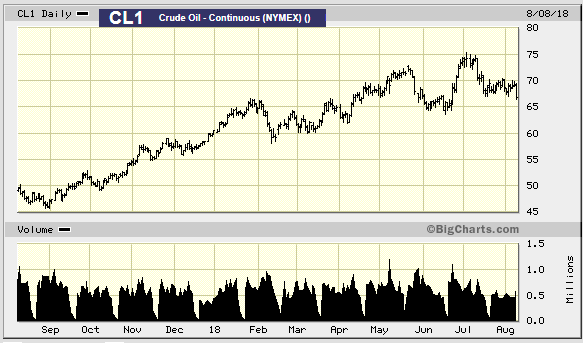by Jim Lane
For several years now we have seen a significant number of players pivoting from biofuels towards smaller but higher-value markets in chemicals, nutrition, nutraceuticals, pharma, materials, flavorings, fragrances, cosmetics and more. We’ve reported on the proliferation of applications both in the Digest and in What’s Nuu? and indeed there’s been so much that’s Nuu, it’s been dizzying at times with all the spinning and twirling.
Capital costs and policy uncertainty have played their part, but the foot on the pedal for many has been oil prices. The scale of operations to compete with oil prices in the 2014-2017 period was too tough for many business models, and too daunting for many investors. The rush for the “other markets” exits felt like a theater on fire.

Now, oil prices have been on a rise for more than two years and now are significantly higher than they were back in 2005 when oil prices, climate change and energy security fears spooked nations around the world to enact biofuels programs.
Today, West Texas Intermediate is priced at $68.14 per barrel, Brent Crude is now at $74.05. And for Europeans it is even worse, for the US dollar has significantly appreciated against the Euro since 2005.
In August 2005, the spot price for Brent was $63.98, or €51.60. Today, the spot price for Brent equates to €63.83. That’s a price rise of 23.7 percent, which means that prices are roughly keeping pace with inflation (around 25 percent) and that, relatively speaking, we’re back in the same energy cost and demand scenario we were back in 2005.
We might add, no expert is predicting a fall in energy prices in the next few years. Predictions range from the 80s and a number of experts have tipped prices over $100 by 2020-21. And the renowned Phil Verleger pointed to as much as $200 by 2021. More on his reasoning here.
The RFS turns 13 today
Thirteen years ago this week, the Renewable Fuel Standard (RFS) was signed into law, sparking a new era of U.S. biofuel leadership that continues to support rural jobs, increase energy security, and deliver clean, affordable options at the fuel pump.
What have governments accomplished? Excepting a number of rollbacks in alternative fuels policies, not much. There are no federal standards put in place anywhere in the US or EU more ambitious than those established in the 2000. Vehicle efficiency standards are being rolled back in the US. The RFS is under an active and continuous siege. The EU has rolled back alternative fuels targets and enforced those that remain with a double-counting gobbledygook that helps no one. Enough economic starvation and despair has been imposed on the pioneers in the bioeconomy that it invokes memories of the siege of Leningrad in 1941-44, or if you consider all the mergers and acquisition activity, the Donner Party of the 1840s forced to eat their own to survive.
“For 13 years, the RFS has been a driving force for economic opportunity across the heartland,” said Kevin Skunes, president of National Corn Growers Association and a North Dakota farmer. “Today, biofuels are more important than ever. Farm income has fallen to a 12-year low, and the EPA’s refinery waivers have left more and more families facing an uncertain future. The EPA can address this uncertainty and take action now by approving year-round sales of ethanol blends greater than 10 percent, accounting for exemptions granted to refineries and reallocating exempted volumes to keep the RFS whole.”
Fuels on the comeback trail
It’s been instructive to hear the word “fuels” appearing on more and more lips these days when looking at applications of industrial biotechnology. It’s been a wonder to behold all the innovation in application development, but fuels remain the largest and by far most important market for industrial biotechnology and for biomass growers. Size dictates that. But the political dimensions of a world where some have access to abundant and affordable energy while others have restricted and pricey access — that’s a recipe for political instability across the globe, and is a major blendstock in the brew of global trade woes right now.
Velocys advances in Mississippi
So, it is exciting news that Velocys (VLS.L, OXFCF) has announced announced a significant environmental milestone for its Bayou Fuels biorefinery project in Mississippi.
The U.S. Department of Agriculture (USDA) has issued a Finding of No Significant Impact (FONSI) on the environmental assessment report for Velocys’ planned Bayou Fuels biorefinery in Natchez, Mississippi. The 160-page environmental assessment report details the impact of the proposed facility across 15 potential aspects, including: land use, water resources, air quality, wildlife, visual impact, noise, transport and public and occupational health.
“This is a significant step in the permitting of the Bayou Fuels biorefinery as well as an important milestone for the overall development of the project,” said David Pummell, Chief Executive Officer of Velocys. “The environmental assessment provides independent confirmation that the project will not give rise to any significant environmental impacts and reflects our commitment to responsible and safe project development.”
The FONSI was issued as part of Velocys’ ongoing development of a 100-acre site in Natchez that the company secured in October 2017. The site will be home to a pioneering biorefinery that will use Velocys’ innovative technology to produce low-carbon transportation fuels from the wood wastes of lumber operations and tree plantations. The plant is expected to convert locally-sourced woody biomass waste into enough renewable fuel to meet the demands of running around 40,000 diesel and gasoline trucks.
But let’s not make the attractiveness of fuels an excuse to overlook the importance of all those applications developed in 2014-2017. When oil prices dip again, as they always do when significant market share goes to a petroleum competitor, investors will be glad that alternatives continue to abound. Even if they have smaller markets, even if they lack the kind of mandates and government push that advances and protects alternative fuels in their infancy.
SECOS bioresin plant goes live in Malaysia
So, it’s delightful to see that bioplastics developer SECOS Group (SES.AX) has advised markets that its Malaysian resin plant has successfully gone live, as of last week.
The Company has delivered initial production of SECOS resin to local customers and trials of the resin have been fully approved for commercial supply. SECOS plans to ramp up production at the new facility over the coming months to meet growing demand for the Company’s proprietary resins while maintaining the highest levels of quality control.
We’ll also be watching carefully for sings of ramp up at LanzaTech, which also is commissioning and optimizing at its first commercial in China — a most interesting venture, especially to those who saw this weeks The Early Stage presentation by Anellotech CEO David Sudolsky, who noted that Anellotech technology produces a CO stream aside its prized bio-based BTX molecules. CO is a feedstock of choice for LanzaTech, and its interesting to see that woody biomass can be a solid companion to steel off-gases and orchard waste that are the primary feedstocks employed at LT’s first raft of projects in India, California, China and Belgium.
The Bottom Line
Expect more and more techno-economic analyses to give a green light to alternative fuels as oil prices head toward $100 a barrel. The tipping point may well be when Brent hits the $80 mark — at that point, we’ll have a €69 oil price in the EU, up 35% since 2005, and Europeans at that stage may be wondering exactly where are all the alternative fuels — and if they have not been made in great quantities in the EU using awesome European technologies and abundant, affordable, sustainable local feedstocks, the remedy lies in European hands.
Jim Lane is editor and publisher of Biofuels Digest where this article was originally published. Biofuels Digest is the most widely read Biofuels daily read by 14,000+ organizations. Subscribe here.








